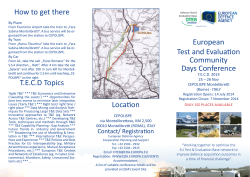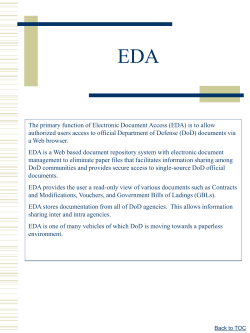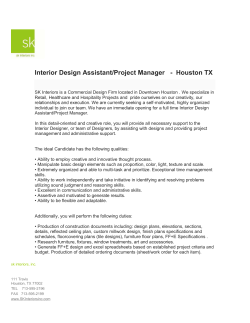
T How to Get the Most from Today’s Advanced EDA Tools
From September 2002 High Frequency Electronics Copyright © 2002, Summit Technical Media, LLC High Frequency Design USING EDA TOOLS How to Get the Most from Today’s Advanced EDA Tools By Gary Breed Editorial Director T his article covers two aspects of Electronic Design Automation (EDA) tools and how they are used. First, a number of suggestions are offered to help you use these tools more efficiently and effectively. Then we’ll describe recent efforts by major EDA companies to make their software easier to use for both novice users and advanced designers. EDA tools have become essential in the design of all electronic circuits and systems. It is a useful reminder to list the major reasons why they are so important: EDA tools use the speed and power of computers—Of course, this is obvious. But, it is still worth remembering that developing mathematical descriptions of physical phenomena is a serious research task, and capturing those increasingly complex mathematics is a challenge for software developers. They use the organizational power of computers—Once a project is underway, computers are an ideal way to store, track, analyze, print and share the results. Over the past few years, this part of EDA technology has improved dramatically. They capture valuable knowledge of the technology—First, the results of research are captured and coded by the EDA development team. Next, the computations are matched to the engineering design process through inhouse testing and user feedback. Finally, the successful results of each user become a valuable part of his or her company’s Intellectual Property (IP) resources. Here are tutorial-level recommendations for users of modern EDA tools, plus a summary of EDA vendors’ efforts to help new and experienced users achieve success with their high frequency designs 20 High Frequency Electronics This month’s cover depicts some of the simulations that an EDA user might perform. One rule to remember In my 30+ years of experience, I have heard the following advice many times, given by the best engineers: Computers don’t design, engineers do. This statement does not mean that beginners should not rely on EDA tools to create new designs, or that we shouldn’t trust the results. After all, the experience of many brilliant designers is embedded in these tools! This rule is only meant to remind us of the classic computer problem of “garbage in = garbage out.” Even the best software will sometimes provide unworkable results. The user simply needs to have either the experience or the supervision to confirm that the problems are properly set up and that the results are legitimate. High Frequency Design USING EDA TOOLS EDA usage recommendations The following series of hints, reminders and suggestions has been developed over many years through the author’s involvement in the RF and microwave engineering profession. These are not necessarily in a priority order: First, understand the problem on paper—It is hard to perform any engineering task without an organized approach, and the EDA environment magnifies errors that arise from a poorly-conceived problem. There is an unconscious tendency to believe what the computer tells you, especially by others in your design team who may not be aware that your work is less well-defined than it should be. Use your knowledge first, then add the knowledge contained in the software—This is an extension of the above concept. The standard circuits available in the EDA tools’ libraries may be perfectly acceptable for portions of many designs, but it is important to understand when they are not. This requires in-depth knowledge of the tool and its capabilities. I have heard too many stories about engineers who simply use what’s available from the software because it’s easy, then let someone else fix it. Keep the documentation current— This needs several exclamation points, according to top engineers. The latest versions of today’s EDA tools have better built-in data management than earlier releases. But, it is too easy to discard previous iterations after they have been improved. A disk drive “file trail” is just as important as your engineering notebook’s “paper trail.” Engineers in small companies should beware; the discipline required to maintain good records is a special challenge, but the development of valuable intellectual property requires it. Use the right tool for the job—This seems obvious, but in the heat of the battle to get a project completed, it may seem convenient to “get close 22 High Frequency Electronics enough” with a simulation method that is not up to the task. When EDA vendors emphasize the need to augment linear and non-linear circuit theory simulation with electromagnetic analysis, it’s not all sales pitch. This year’s designs are at higher frequencies than last year’s, and EM analysis is more important than ever to assure that the effects of physical size, layout and packaging are taken into account. ...the EDA environment magnifies errors that arise from a poorlyconceived problem. Tend to the design details—This covers a lot of scenarios, from choosing right type of segmentation for an EM analysis problem, to using the component model that has the necessary accuracy for your application. A current trend is for full-system simulation, where the size of the analysis problem is extremely large. It is essential that each part of the system is executed properly, since it affects the overall signal chain. Finally, the pet peeve of more than a few engineering managers: Use the optimizer last, not first— Yes, there has been much research into optimization algorithms that do not have false convergence at a “local minimum.” But, it is still important for an engineer to be close enough to the final answer before optimization to have full confidence that his tools have delivered the right answer. There is an exception to this rule for the exploration of different topologies. For example, an engineer might want to try out several matching networks. A small-size problem can be quickly set up and run through the optimizer. The results can be compared to see which topology provides the necessary bandwidth, or if a good match can be obtained using a configuration with DC continuity for biasing. This trial result is then added to the larger circuit and thoroughly analyzed before a final optimization. These recommendations are fundamental instructions that we all learned long ago, yet are regularly forgotten or bypassed under the pressure to get the current job finished! Taming Complexity, Connecting With Users The headline on this issue’s cover refers to the efforts of EDA vendors to make their tools more accessible. The work toward making these increasingly complex tools “easier to use” focuses in these main areas: Helping novice users learn to use the software more quickly; making experienced designers more productive; and helping design teams share results and handle large problems. These issues are at opposite ends of the user spectrum, but they represent the reality of engineering—getting as much done as possible while remembering to bring the next generation of designers up to speed. The first area to note is the onscreen user interface. Placing menus, lists, plots, etc. in logical places on the screen is both an engineering and artistic challenge. That challenge continues with organizing the nested commands that are required to access the more detailed functions. All companies are working on this issue, each with variations in the approach. Users should carefully evaluate how easy it is to navigate around each vendor’s product. In the area of help for new engineers, some EDA companies offer “student version” and “free trial” policies. Ten years ago, this would have been heresy, since many users would simply rely on the limited-performance free versions. But those free versions, while useful for pieces of the design puzzle, fall far short of handling problems of significant size. However, they give students and High Frequency Design USING EDA TOOLS experience before making the investment in the full-feature version. The company also offers SonnetLitePlus, a budget priced upgrade which handles problems with twice the memory usage, for users with modest analysis requirements. Although not well known in the Sonnet Lite has provided a no-cost U.S. until recently, Europeans and introduction to EM analysis for many the academic community have used microwave engineers. the demo version of APLAC for several years. This program gained attention for its non-linear simulation beginning engineers an opportunity capability, which was not available in to apply current technology to small- other free or demo software. size problems. Applied Wave Research (AWR) An early proponent of this policy offers a 30-day trial version of its was Compact Software (since software packages, allowing time for acquired by Ansoft), which allowed learning enough about the product to the U.S. amateur radio organization, make a careful evaluation before the American Radio Relay League, to making a purchase. Other companies market ARRL Radio Designer, a $150 have 30-day money back policies that limited-feature version of the accomplish the same thing, albeit SuperCompact linear simulator. with an initial payment. Radio Designer has now been disAnother approach to helping continued, in part due to the avail- novice users is built-in wizards and ability of Ansoft’s free SV (“student standard analysis setups. These can version”) editions of Serenade, their guide a new user through the process linear and nonlinear simulator, and of a typical design. As an example, Ensemble, a planar EM simulator. the “DesignGuides” in Agilent Sonnet Software was the first com- Technologies’ Advanced Design pany to make planar EM simulation System contain preset setups (such available at no charge. Sonnet Lite is as the load pull setup in the figure sufficiently powerful to analyze many below) that can be used as-is or modmicrostrip and stripline circuits, ified to fit a particular need. including coupled lines, filters, inter- ADS2001 introduced this and other connects and spiral inductors. major enhancements to help make it Potential customers can gain valuable easier to get up to speed on what is arguably the most thoroughly-configured—and complicated—EDA package for high frequency design. Most companies’ system-level simulators include standard setups that include parameters for all of the major wireless standards, including 2.5G, 3G, Agilent ADS includes pre-defined DesignGuides like Bluetooth and curthis load-pull example. rent WLAN systems. 24 High Frequency Electronics Making it Easier to Access EDA Computing Power Advanced users of EDA tools can benefit from assistance, too. Some users are true “power users” with a high level of competence in a particular toolset. These users want features that make them more productive, especially when using multiple tools, and sharing data with several team members. Compatibility with other tools has been addressed by CST in their Microwave Studio (MWS) and Design Studio. Using an open design environment, MWS can be tightly integrated with other compliant software, including Agilent ADS and Sonnet. CST, along with other 3D electromagnetic analysis tool vendors such as Zeland, Agilent and Ansoft have devoted significant development resources to the issue of entering the mechanical descriptions of the structure to be analyzed, using standard file formats like DXF or Gerber that are commonly provided by mechanical CAD programs. Then, these products use carefully-derived and tested algorithms to automatically create the segmentation that will result in an accurate solution with efficient use of computing resources. Large comprehensive tools like Agilent’s ADS are loaded with features that permit the user to use each individual tool, in conjunction with full-system simulation, and even links to and from “real world” test instruments that combine simulated and measure results. The recentlyannounced Ansoft Designer is a major step in this direction for that company. Future Developments There are many more ideas under consideration to help the engineerEDA tool connection. Online access charged by CPU time, contract EDA services, improved “standard” file formats and distributed computations are all being developed as options for high frequency designers, with many more ideas yet to be tried.
© Copyright 2025



















